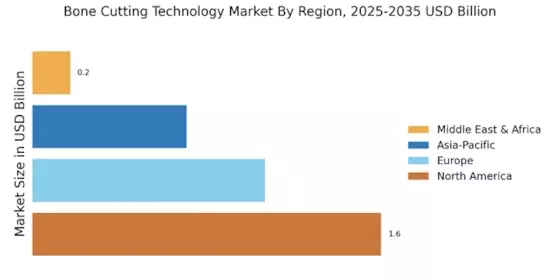Increase in Sports-Related Injuries
The rise in sports participation across various age groups has led to an increase in sports-related injuries, which in turn fuels the demand for bone cutting technologies. As athletes seek effective treatment options for injuries such as fractures and ligament tears, the bone cutting technology market is poised for growth. In 2025, the market is likely to see a surge in the adoption of advanced surgical techniques and instruments designed specifically for sports medicine. This trend indicates a growing recognition of the importance of specialized bone cutting technologies in addressing the unique needs of athletes, thereby contributing to the overall expansion of the bone cutting technology market.
Rising Demand for Orthopedic Surgeries
The increasing prevalence of orthopedic conditions, such as arthritis and fractures, drives the demand for advanced bone cutting technologies. As the population ages, the incidence of these conditions rises, leading to a greater need for surgical interventions. In 2025, the bone cutting technology market is projected to witness substantial growth, with a significant portion attributed to orthopedic surgeries. The market is expected to expand as healthcare providers seek innovative solutions to enhance surgical outcomes and reduce recovery times. This trend indicates a robust demand for precision instruments and technologies that facilitate effective bone cutting procedures, thereby contributing to the overall growth of the bone cutting technology market.
Government Initiatives and Funding for Healthcare
Government initiatives aimed at improving healthcare infrastructure and access to advanced medical technologies are likely to bolster the bone cutting technology market. Increased funding for healthcare facilities and research initiatives can lead to the adoption of innovative bone cutting technologies. As of 2025, various governments are expected to implement policies that promote the integration of advanced surgical instruments in hospitals and clinics. This support may enhance the capabilities of healthcare providers, allowing them to offer better surgical outcomes. Consequently, the bone cutting technology market stands to benefit from these initiatives, as they create a conducive environment for the growth and adoption of cutting-edge technologies.
Growing Awareness of Minimally Invasive Procedures
There is a notable shift towards minimally invasive surgical techniques within the bone cutting technology market. Patients and healthcare professionals alike are becoming more aware of the benefits associated with these procedures, including reduced pain, shorter recovery times, and minimal scarring. This trend is likely to drive the demand for advanced bone cutting technologies that facilitate such techniques. As of 2025, the market is expected to reflect this growing preference, with an increasing number of surgical procedures being performed using minimally invasive methods. This shift not only enhances patient satisfaction but also encourages healthcare providers to invest in innovative technologies that align with these evolving preferences.
Technological Advancements in Surgical Instruments
The bone cutting technology market is experiencing rapid advancements in surgical instruments, which enhances the efficiency and precision of surgical procedures. Innovations such as robotic-assisted surgery and computer-aided design are becoming increasingly prevalent. These technologies not only improve the accuracy of bone cutting but also minimize the risk of complications during surgery. As of 2025, the market is likely to benefit from the integration of artificial intelligence and machine learning, which could further optimize surgical workflows. The continuous evolution of these technologies suggests a promising future for the bone cutting technology market, as healthcare providers increasingly adopt these advanced solutions.


















Leave a Comment